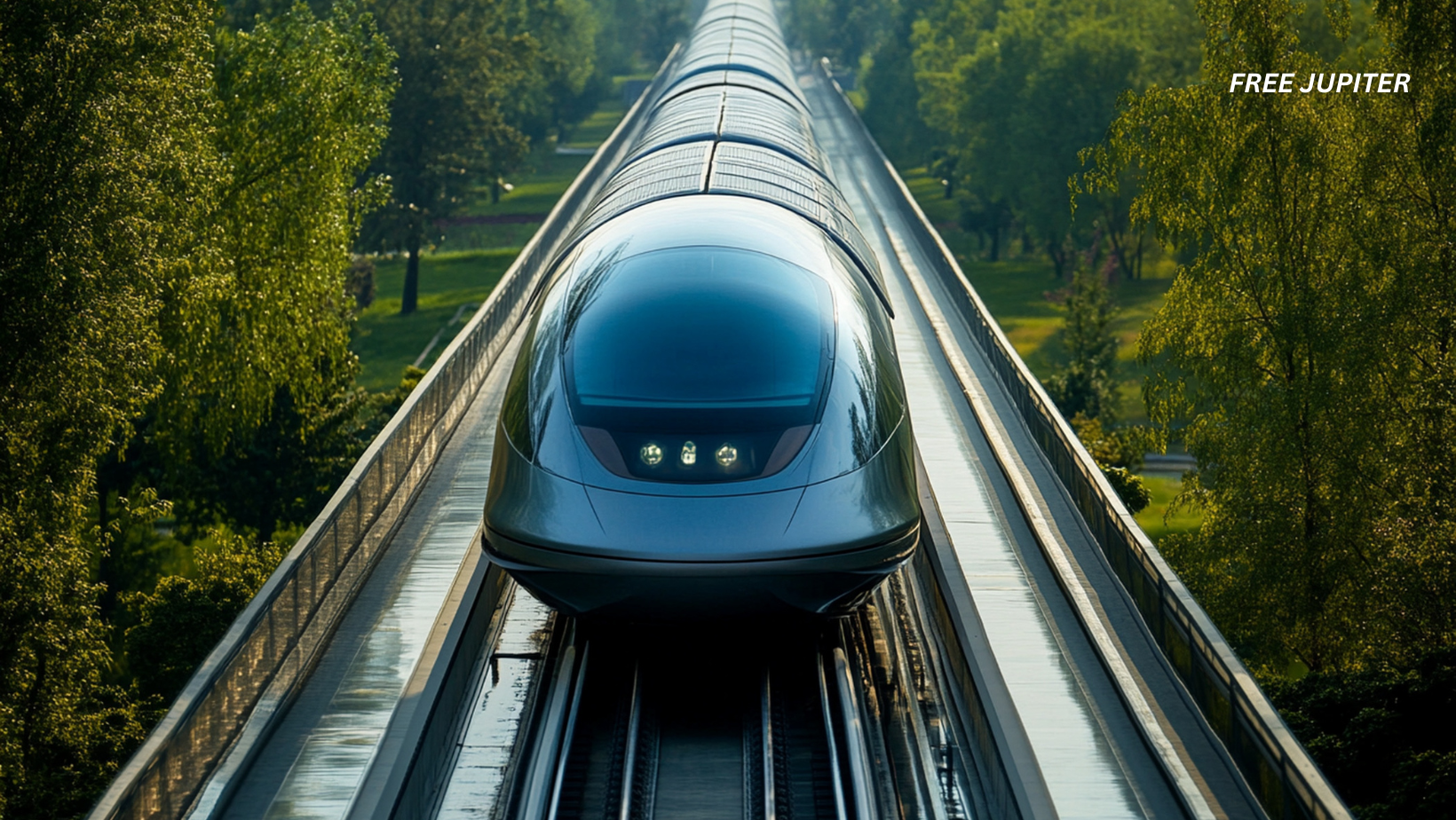Friendly Note: FreeJupiter.com shares general info for curious minds 🌟 Please fact-check all claims—and always check health matters with a professional 💙
In a world where traffic jams, flight delays, and worn-out rail systems still test our patience daily, one country seems determined to skip the line and dive headfirst into the future of transportation. While the United States continues to patch together its aging infrastructure, China is making headlines for a levitating train that could eventually zip across massive distances in record time.
If it works as planned, it might just be faster than flying — and certainly more thrilling.
What Exactly Is a Maglev Train?
Let’s break it down. “Maglev” stands for magnetic levitation. Rather than using wheels like a traditional train, maglev trains hover slightly above the track using powerful magnets. This means there’s no physical contact with the rails, and with friction out of the equation, speeds can soar.
It’s the same basic principle as trying to push two magnets together with the same poles facing each other — they repel. Now imagine that force being used to lift an entire train off the ground. Add some smart engineering, and you’ve got a ride that glides silently and smoothly at jaw-dropping speeds.
China’s Latest Breakthrough: Speeds of 800 km/h
Chinese engineers have taken this idea and turned it into a working prototype that hits 650 kilometers per hour, which is around 400 miles per hour. But the goal doesn’t stop there — they’re targeting an operational speed of 800 km/h, nearly 500 mph.
To put this into perspective, a flight from New York to Chicago takes about two and a half hours (not counting airport check-ins or delays). A train moving at 800 km/h could do that in just two hours — or less — with no turbulence and no taxiing down runways.
The ambitious maglev project was first unveiled back in 2019 by Chinese state media. Since then, a dedicated test facility and production lab have been set up in the coastal city of Qingdao. This is where the magic happens — engineers have been fine-tuning the prototype and showcasing its performance at international rail conferences, such as the 12th World Congress on High-Speed Rail in Beijing.
Read more:Scientists Say Life Once Thrived on Mars—Then Caused Its Own Extinction
From Rubber Tires to Floating at Nearly 500 mph
At first glance, the maglev might not look all that different from a typical bullet train. But under the hood, it’s a marvel. During startup, the train rolls along like any other, using standard rubber wheels. But once it builds up to 100–200 km/h, the transformation begins.
The wheels retract, and the train lifts ever so slightly off the track — less than half an inch. From that moment, it’s all magnetic propulsion. The lack of contact not only makes it more efficient but also whisper-quiet, with far less vibration and wear-and-tear.
Li Weichao, the head of the testing lab, shared that the train can reach 650 km/h within a stretch of just one kilometer of track. Even more impressively, the train was designed with a cruising speed of 800 km/h in mind — making it the fastest train system ever built.
A New Era in Public Transit—But Not Without Challenges
China’s project may seem like a miracle of engineering, but actually building the full infrastructure to support these high speeds is another story entirely. Creating a maglev network isn’t as simple as upgrading old tracks — it requires a completely new system, designed from the ground up with specialized magnetic rails, complex support systems, and vast land clearance.
It’s expensive — and not everyone has the resources or political drive to push it forward.
Take Japan, for example. Known for its early leadership in high-speed rail (think Shinkansen), the country has been developing its own maglev system for years. But a political battle over a tunnel through the Japanese Alps forced the country to delay its $64 billion project by almost a decade. That’s a massive setback for a country already so far ahead of the curve.
And in the United States, things aren’t moving much faster. A proposal to build a maglev line between Washington, D.C., and Baltimore, which would reduce travel time to just 15 minutes, remains tangled in environmental studies, legal challenges, and debates between state and federal agencies. Years in, the project is still on hold.
China Already Holds the Speed Record
While other countries stall, China is speeding ahead — quite literally.
They already operate the world’s fastest commercial train, the Shanghai-Hangzhou maglev, which can reach 431 km/h (roughly 267 mph). That’s still far below their new prototype’s potential but still faster than any other train currently in operation worldwide.
This makes China the most likely candidate to bring ultra-high-speed maglev travel to the masses. If they can scale this technology across major cities, they could revolutionize the way people commute, work, and travel across the country — or even the continent.
Read more: Going to Bed Without Eating Could Supercharge Your Memory, Scientists Say
Can Maglevs Compete with Air Travel?
So, will maglevs replace airplanes anytime soon?
Well, not quite — but they might change the game for medium-distance travel. For routes between cities 500 to 1,000 miles apart, maglevs could offer a faster, more convenient alternative. There are no security lines, boarding gates, or hour-long delays on the tarmac. Plus, the energy consumption per passenger could be far lower than commercial jets — especially if powered by clean electricity.
If built at scale, maglev trains might become the eco-friendly future of fast travel, offering comfort, speed, and efficiency that cars and planes simply can’t match.
The Real Hurdle: Building the Tracks
Here’s the tricky part: maglev trains can’t just use existing railways. They require entirely new infrastructure, which is costly and time-consuming. The guideways — basically the elevated magnetic tracks — must be built with extreme precision, and they take up significant space.
There’s also the question of funding. While countries like China can greenlight such massive projects through centralized government planning, other nations, especially democratic ones like the U.S., face a web of legal approvals, land disputes, and budget wrangling.
In short, the technology is ready, but the world isn’t — at least not yet.
Other Countries Exploring Maglev Technology
While China is leading the charge, other nations aren’t sitting idle. Here’s a quick look at what’s happening around the globe:
- Japan is still committed to its maglev dream, with the Tokyo-to-Nagoya line expected to launch by 2037 — delays and all.
- South Korea has operated a low-speed urban maglev in Incheon since 2016, mostly used for airport transit.
- Germany, the birthplace of maglev technology, has shifted its focus toward hybrid rail systems, but still contributes engineering expertise to international projects.
- The U.S. remains in the idea phase, with most high-speed train proposals facing uphill battles in terms of funding and approvals.
Read more: Scientists Just Used CRISPR Gene Editing to Reverse the Root Cause of Down Syndrome
A Glimpse Into Tomorrow’s Commute
Whether or not China’s 800 km/h train becomes a daily reality, it offers a tantalizing preview of what modern transportation could look like. Imagine hopping on a sleek train in Chicago and arriving in New York in less time than it takes to finish a movie. No layovers. No seatbelt signs. Just a smooth, levitating ride at nearly half the speed of sound.
Sure, it sounds like something out of a futuristic video game. But China’s engineers have already built the prototype. Now, it’s just a matter of time — and track.
Until then, most of us will just have to settle for the slow lane. But one thing’s clear: the future is hovering just above the rails.










